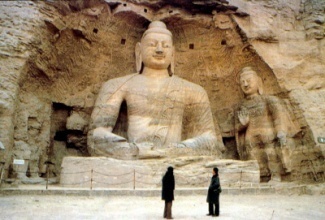Table 1.
On the left is Terracotta (Kneeling Archer), a pottery work from the Qin Dynasty obtained from tomb of Huangdui, a Qin Emperor. On the right is The Seated Buddha, a sandstone carving from the Northern Wei Dynasty obtained from a cave along the Silk Road in China. The Northern Wei Dynasty was the longest and most powerful Dynasty in the northern China region prior to the unification of mainland China under Tang and Sui dynasties. It existed between AD 386 and AD 535. Due to the presence of large nomadic groups of Chinese people in the northern regions, the Wei dynasty launched offensive against other groups in Northern Mongolia around 439 BC, thus increasing their territories. However, their culture was relatively weak. They also intermarried with the Han, thus adopting their languages, customs, belief systems and cultures.
Terracotta (kneeling archers) and the Seated Buddha are two different artworks from different groups of people in different periods of Chinese history. As the name suggests, the seated Buddha is a religious symbol, while the Terracotta is a symbol of power, politics and war. Historians argue that the style of decoration used to furnish the Seated Buddha was originally an artwork of India. On the other hand, the Qin Dynasty was associated with increased offensive against its neighbors. The Terracotta symbolizes the importance of military to the empire. Historians indicate that the Qin Emperors were interested in expanding their territories, which progressively increased the empire with the conquest of various kingdoms and tribes.
The Terracotta is a product of ancient Chinese pottery. During the Qin dynasty, pottery was an important aspect of life. Since stone and jade were difficult to make, pottery remained an important social and economic activity. On the other hand, the Seated Buddha is made of carved stones. It is a curved sandstone (living rock), which is relatively huge.
While the Terracotta is a product of pottery, the Seated Buddha is a product of stone carving. The kneeling archer takes the form of a soldier at a warfront. Archers were important military wing, equal to the modern day military snipers. On the other hand, the seated Buddha takes the form of the religious founder of Buddhism. Unlike the original forms that depicted Buddha praying, this figure shows that the belief system was prone to change in different cultures.
While the Terracotta can be viewed from all sides, the seated Buddha cannot be viewed from behind because it was carved from a living rock. In addition, the Terracotta is a small and movable object while the Seated Buddha is fixed on a rock. The technique used to make the seated Buddha is simply stone carving. However, it has produced an object that conveys the artist’s information. The Terracotta is movable object, which is one of more than 7500 terracotta soldiers excavated at the Shang Huangdui’s tomb. Thus, its mobile state represents the soldier’s swift actions at war.
The largest terracotta obtained from the tomb is about 48 inches in height while the smallest is about 38 inches. On the other hand, the Seated Buddha is a relatively large object, measuring about 45 feet in height. As mentioned above, both objects are decorated. The seated Buddha was decorated with natural colors, but the color is already invisible due to wearing out. On the other hand, decorations on the terracotta were made by making clay figures on the soldier’s body, including a decorated armor.
The Seated Buddha is a religious representation of Buddha, a religion that was borrowed from India through the Silk Road connection. On the other hand, the Terracotta represents a political aspect of life because the emperors were constantly using soldiers to invade other kingdoms to increase their political significance. The Terracotta was obtained from an emperor’s tomb, which means that they were meant to protect the departed soul. The artist must have been hired by the Emperor’s palace. On the other hand, the Seated Buddha was made for religious purposes.
Thus, it must have been funded or initiated by monks. The seated Buddha is a social cultural figure that represents the entry of Buddhism from Indian through the Silk Road contact. On the other hand, the terracotta is a political and cultural figure that represents the importance of soldiers during the dynasty and after the death of an emperor. Both objects depict masculine roles in the society. Al Chinese dynasties did not allow women to take roles in the military or religious rituals. The Seated Buddha was used to show the presence of Buddhist founder’s spirit as well as knowledge among the people. The terracotta was used to provide protection to the soul of the departed emperor.
Table 2.
On the left is a painting known as “Ladies Wearing Flowers in their Hair” by Zhou Fang that was made during the Tang Dynasty. On the left is a painted banner bearing the name of Lady Fei of Dai and used to cover her coffin that was found in Mawangdui in Hunan Province. It dates back to 168 BC during the existence of the Western Han Dynasty. The Han Dynasty, which existed between 206 BC and 220 AD, was an offshoot of the Qin Dynasty after its collapse. The collapse of the Qin Dynasty led to uprising of several empires that constantly fought with each other. Chu Huan and other leaders founded the western Han. The Sui kings founded the Tang Dynasty some 300 years after the collapse of the Han Empire. It quickly prospered from trade and agriculture. There was an increased trade between the Tang and Persians, Arabs,
The painting “Ladies Wearing Flowers in their Hair” is a Chinese art from the Tang Dynasty. It depicts the events and scenes at a royal house or a palace in the kingdom. Historians argue that the political and economic stability of the Tang Dynasty allowed such scenes, where women played an important role in catering at the royal homes. The clothes and flowers the women are wearing provide an example of the improved lifestyles and presence of beautiful clothes from an improving industry as well as trade in the Kingdom. The “Silk Banner” on the right hand of figure 2 above provides evidence of life after death during the Western Han regime. It bears the name of Lady Dai and depicts the social abstracts and cosmos. Both objects are paintings on silk using ink and color. These were important trade items in the ancient China. In fact, silk was a traditional Chinese garment that becomes an important export to other parts of Asia, Eastern Europe as well as northern and eastern Africa during the Silk Road trade.
The “Painted Banner Feiyi of Dai” is a banner used to provide the name of the dead person. It replaced a portrait of the women. On the other hand, “women wearing flowers” depict maidens in a royal home wearing bright clothes and flowers, some moving around and others playing with a frog. Both objects are products of techniques that evolved through time. Silk was obtained from silk worms while color was obtained from plants, soil and animal parts. The message in the banner was made by writing, thus conveying the message (the name of the dead). The painting of women and their activities in a courtroom shows the good lifestyle of the noble people.
The painting of women with flowers was meant to portray the events in royal palaces and homes of the noble men. Women served as chefs, maids and wives. The banner replaces a portrait of the departed person and provides evidence of belief in life after death. The painting of women with flowers signifies a number of social issues. For instance, it depicts the nature of life at the palaces, the product of political stability and trade between empires and importance and roles of women in the royal palaces. On its part, the banner signifies belief in life after death as well as importance of keeping records through writing.
Zhou Fang and his son were important decorators and painters during the Tang Dynasty. In this case, it is evident that he was sponsored or commissioned to provide the work by a certain individual at the royal palace. Although the name of the artist who made the banner is not known, it is evident that Lady Dai commissioned the work before her death or her relatives. Gender issues are evident in these works. First, the painting of women with flowers provides evidence of the roles that women played in the society. It indicates that they were special persons whose worth was measured through beauty. Royal women and their servants were highly decorated to show the might of their male owners. On the other hand, the banner provides evidence that women were also important figures in the society. The banner is used to provide the details of the dead person while the painting of royal maids shows how life was in the palaces.
By analyzing these artworks, I realize that the Chinese arts took subjects of the prevailing social, political and cultural aspects. For example, arts proliferated with political and economic stability.
Bibliography
Benn, Charles. China’s Golden Age: Everyday Life in the Tang Dynasty. London: Oxford University Press, 2010.
Holcombe, Charles. A History of East Asia: From the Origins of Civilization to the Twenty-First Century. London: Cambridge University Press, 2011
Kessler, Adam T. Empires beyond the Great Wall: The Heritage of Genghis Khan. Los Angeles: Natural History Museum of Los Angeles County, 1993.
Lee, Sherman. A History of Far Eastern Art. New York: Prentice-Hall, 2009.
Lewis, Mark. The Early Chinese Empires: Qin and Han. London: Belknap Press, 2007.




